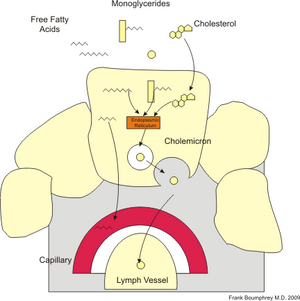Digestion of lipids
Fats are ingested in the form of triacylglycerols (up to 90%), phospholipids and cholesterol esters. Lipids are poorly soluble in water, so triacylglycerols are cleaved by lipases, which are produced by the Ebner glands of the root of the tongue, the gastric glands, and the acinar cells of the pancreas.
The process of digestion of lipids[edit | edit source]
Approximately 10-30% of triacylglycerols are digested in the stomach, where the acidic pH ensures the optimal conditions for the activity of the lingual and gastric lipase. The rest is cleaved by pancreatic lipase in a pH neutral environment of the duodenum and jejunum. For optimal lipase activity, fat emulsification is necessary, which gives the enzymes a larger surface area for the process. In the stomach, fats are emulsified mechanically by the motility of the aboral part of the stomach, in the small intestine by bile acid salts and lecithin. The lipolytic effect of pancreatic lipase is conditioned by the presence of colipase, which as an enzyme of pancreatic juice binds to fat droplets. Digestion of triacylglycerols results in free fatty acids, mono- and diacylglycerols. These products are converted with the participation of bile acid salts into micelles, which are a necessary condition for the normal absorption of fats.
Absorption of lipids[edit | edit source]
The micelles travel between the microvilli and their contents are dispersed in a slow-moving fluid. At this place the lipids reach high concentrations and thanks to their hydrophobic properties diffuse through the luminal membrane of enterocytes. They accumulate in the vesicles of the smooth endoplasmic reticulum, where they again form lipid molecules. Their surface is covered by phospholipids and β-lipoprotein formed in the ribosomes of enterocytes.This creates chylomicrons (fat droplets), which leave the cell by exocytosis into the basolateral space. Because chylomicrons are too large, they would not pass through the basement membrane into the blood capillaries, and so they enter the lymphatic capillaries and enter the blood with the lymph. Most fats are absorbed in the duodenum and jejunum. The remaining bile acids are absorbed in the terminal ileum, from there they diffuse or are transported by active transport across the luminal membrane and finally pass through the basolateral membrane into the blood.They enter the liver through the portal circulation, where they are excreted into the bile with newly formed bile acids.
Links[edit | edit source]
https://www.wikiskripta.eu/index.php?curid=58620
Literature[edit | edit source]
- KITTNAR, Otomar. Lékařská fyziologie. 1. vydání. Praha : Grada, 2011. ISBN 978-80-247-3068-4.
- SILBERNAGL, Stefan a Agamemnon DESPOPOULOS. Atlas fyziologie člověka. 6. vydání. Praha : Grada, 2011. ISBN 978-80-247-0630-6.

